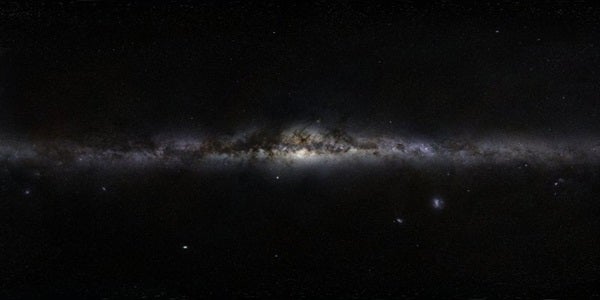The first of three images of the European Southern Observatory’s (ESO) GigaGalaxy Zoom project — a new 800-million-pixel panorama of the entire sky as seen from ESO’s observing sites in Chile — is now available. The project allows stargazers to explore and experience the universe as it is seen with the unaided eye from the darkest and best viewing locations in the world.
This 360° panoramic image, covering the entire celestial sphere, reveals the cosmic landscape that surrounds our tiny blue planet. This starscape serves as the first of three extremely high-resolution images featured in the GigaGalaxy Zoom project, launched by ESO within the framework of the International Year of Astronomy 2009 (IYA2009). GigaGalaxy Zoom features a web tool that allows users to dive into our Milky Way. With this tool, users can learn more about many different and exciting objects in the image, such as multicolored nebulae and exploding stars, just by clicking on them. In this way, the project seeks to link the sky we can all see with the deep, “hidden” cosmos that astronomers study on a daily basis. The wonderful quality of the images is a testament to the splendor of the night sky at ESO’s sites in Chile.
The plane of our Milky Way Galaxy, which we see edge-on from our perspective on Earth, cuts a luminous swath across the image. The projection used in GigaGalaxy Zoom places the viewer in front of our galaxy with the Galactic Plane running horizontally through the image — almost as if we were looking at the Milky Way from the outside. From this vantage point, the general components of our spiral galaxy come clearly into view, including its disc, marbled with both dark and glowing nebulae, which harbors bright, young stars, as well as the galaxy’s central bulge and its satellite galaxies.
The production of this image came about as a collaboration between ESO, the renowned French writer and astrophotographer Serge Brunier, and his fellow Frenchman Frederic Tapissier. Brunier spent several weeks between August 2008 and February 2009 capturing the sky, mostly from ESO observatories at La Silla and Paranal in Chile. In order to cover the full Milky Way, Brunier also made a week-long trip to La Palma, one of the Canary Islands, to photograph the northern skies. Once the raw photographs were in hand, image processing by Tapissier and ESO experts helped to convey accurately the night sky as our eyes see it. The resulting image is composed of almost 300 fields each individually captured by Brunier four times, adding up to nearly 1,200 photos that encompass the entire night sky.
“I wanted to show a sky that everyone can relate to — with its constellations, its thousands of stars, with names familiar since childhood, its myths shared by all civilizations since Homo became Sapiens,” says Brunier. “The image was therefore made as man sees it, with a regular digital camera under the dark skies in the Atacama Desert and on La Palma.”
As photographing extended over several months, objects from the solar system came and went through the star fields, with bright planets such as Venus and Jupiter. A brilliant, emerald-green comet also flew by, although spotting it among a background of tens of millions of stars will be difficult, but rewarding.
Overall, the creators of the GigaGalaxy Zoom project hope that these efforts in bringing the night sky as observed under the best conditions on the planet to stargazers everywhere will inspire awe for the beautiful, immense universe that we live in.
“The vision of the IYA2009 is to help people rediscover their place in the universe through the day- and night-time sky, and this is exactly what the GigaGalaxy Zoom project is all about,” said project coordinator Henri Boffin.










